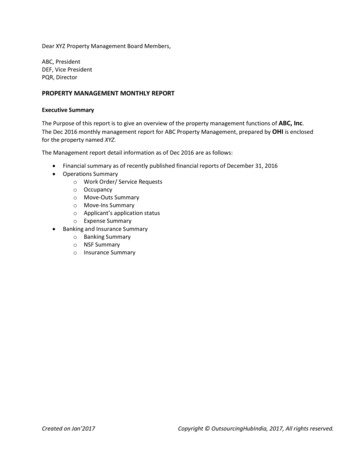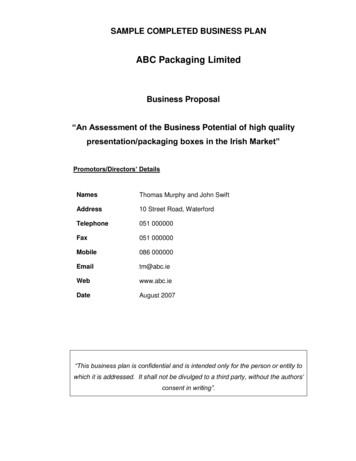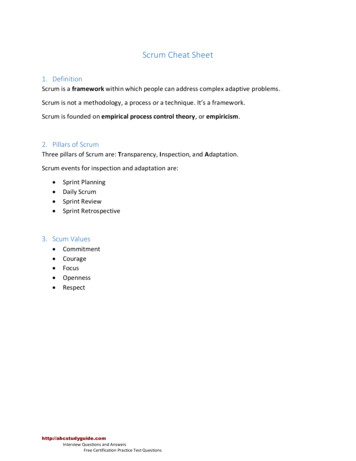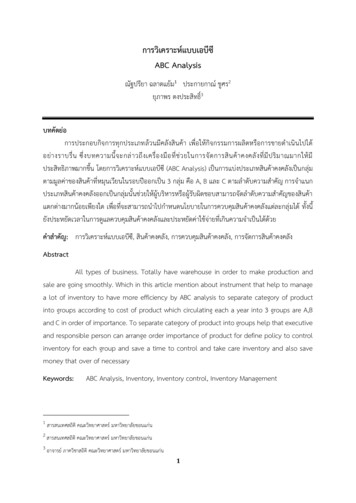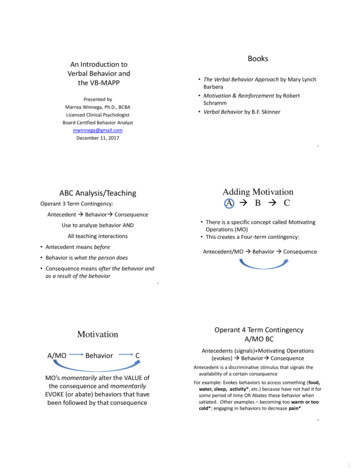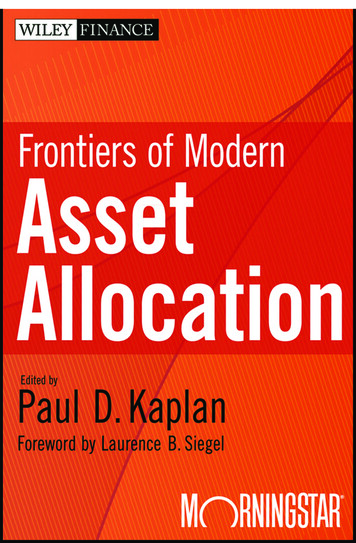
Transcription
P1: TIX/XYZJWBT581-fmP2: ABCJWBT581-KaplanNovember 3, 201110:11Printer: Courier Westford
P1: TIX/XYZJWBT581-fmP2: ABCJWBT581-KaplanNovember 3, 201110:11Printer: Courier WestfordFrontiers ofModern AssetAllocationi
P1: TIX/XYZJWBT581-fmP2: ABCJWBT581-KaplanNovember 3, 201110:11Printer: Courier WestfordFounded in 1807, John Wiley & Sons is the oldest independent publishingcompany in the United States. With offices in North America, Europe, Australia and Asia, Wiley is globally committed to developing and marketingprint and electronic products and services for our customers’ professionaland personal knowledge and understanding.The Wiley Finance series contains books written specifically for financeand investment professionals as well as sophisticated individual investorsand their financial advisors. Book topics range from portfolio managementto e-commerce, risk management, financial engineering, valuation and financial instrument analysis, as well as much more.For a list of available titles, please visit our Web site atwww.WileyFinance.com.ii
P1: TIX/XYZJWBT581-fmP2: ABCJWBT581-KaplanNovember 3, 201110:11Printer: Courier WestfordFrontiers ofModern AssetAllocationPAUL D. KAPLANJohn Wiley & Sons, Inc.iii
P1: TIX/XYZJWBT581-fmP2: ABCJWBT581-KaplanNovember 3, 201110:11Printer: Courier Westfordc 2012 by Morningstar, Inc. All rights reserved.Copyright Published by John Wiley & Sons, Inc., Hoboken, New Jersey.Published simultaneously in Canada.No part of this publication may be reproduced, stored in a retrieval system, or transmitted inany form or by any means, electronic, mechanical, photocopying, recording, scanning, orotherwise, except as permitted under Section 107 or 108 of the 1976 United States CopyrightAct, without either the prior written permission of the Publisher, or authorization throughpayment of the appropriate per-copy fee to the Copyright Clearance Center, Inc., 222Rosewood Drive, Danvers, MA 01923, (978) 750-8400, fax (978) 646-8600, or on the Webat www.copyright.com. Requests to the Publisher for permission should be addressed to thePermissions Department, John Wiley & Sons, Inc., 111 River Street, Hoboken, NJ 07030,(201) 748-6011, fax (201) 748-6008, or online at http://www.wiley.com/go/permissions.Limit of Liability/Disclaimer of Warranty: While the publisher and author have used theirbest efforts in preparing this book, they make no representations or warranties with respect tothe accuracy or completeness of the contents of this book and specifically disclaim any impliedwarranties of merchantability or fitness for a particular purpose. No warranty may be createdor extended by sales representatives or written sales materials. The advice and strategiescontained herein may not be suitable for your situation. You should consult with aprofessional where appropriate. Neither the publisher nor author shall be liable for any loss ofprofit or any other commercial damages, including but not limited to special, incidental,consequential, or other damages.For general information on our other products and services or for technical support, pleasecontact our Customer Care Department within the United States at (800) 762-2974, outsidethe United States at (317) 572-3993 or fax (317) 572-4002.Wiley also publishes its books in a variety of electronic formats. Some content that appears inprint may not be available in electronic books. For more information about Wiley products,visit our web site at www.wiley.com.Library of Congress Cataloging-in-Publication Data:Kaplan, Paul D.Frontiers of modern asset allocation / Paul D. Kaplan. – 1st ed.p. cm. – (Wiley finance series)Includes bibliographical references and index.ISBN 978-1-118-11506-0 (cloth); ISBN 978-1-118-17299-5 (ebk);ISBN 978-1-118-17300-8 (ebk); ISBN 978-1-118-17301-5 (ebk)1. Portfolio management. 2. Investments. I. Title.HG4529.5.K36 2012332.6–dc232011029303ISBN 978-1-118-11506-0Printed in the United States of America.10987654321iv
P1: TIX/XYZJWBT581-fmP2: ABCJWBT581-KaplanNovember 3, 201110:11Printer: Courier WestfordTo my children, Ruth, Rachel, and Benjamin.And to all LGBT people everywhere who serve investors.v
P1: TIX/XYZJWBT581-fmP2: ABCJWBT581-KaplanNovember 3, 2011vi10:11Printer: Courier Westford
P1: TIX/XYZJWBT581-fmP2: ABCJWBT581-KaplanNovember 3, 201110:11Printer: Courier WestfordContentsForewordxiIntroductionxxiiiA Note on Expected Return and Geometric MeanxxvAcknowledgmentsxxxiPART ONEEquitiesCHAPTER 1Purity of Purpose: How Style-Pure Indexes Provide Useful Insights7CHAPTER 2Investing in Europe with Style: Why Investors in Europe Would BenefitFrom Constructing Portfolios Through the Prism of Style15CHAPTER 3Why Fundamental Indexation Might—or Might Not—Work21CHAPTER 4The Fundamental Debate: Two Experts Square Off on the Big IssuesSurrounding Fundamentally Weighted Indexes39CHAPTER 5Collared Weighting: A Hybrid Approach to Indexing51CHAPTER 6Yield to Investors? A Practical Approach to Building Dividend Indexes63CHAPTER 7Holdings-Based and Returns-Based Style Models71vii
P1: TIX/XYZJWBT581-fmP2: ABCJWBT581-KaplanNovember 3, 201110:11Printer: Courier WestfordviiiCONTENTSCHAPTER 8Estimates of Small Stock Betas Are Much Too Low103CHAPTER 9A Macroeconomic Model of the Equity Risk Premium117PART TWOFixed Income, Real Estate, and AlternativesCHAPTER 10Good and Bad Monetary Economics, and Why Investors Needto Know the Difference133CHAPTER 11Inflation, Gilt Yields, and Economic Policy143CHAPTER 12Reverse Mean-Variance Optimization for Real EstateAsset-Allocation Parameters147CHAPTER 13The Long and Short of Commodity Indexes157CHAPTER 14Less Alpha and More Beta Than Meets the Eye175CHAPTER 15Venture Capital and its Role in Strategic Asset Allocation179PART THREECrashes and Fat TailsCHAPTER 16One-and-a-Quarter Centuries of Stock Market Drawdowns193CHAPTER 17Stock Market Bubbles and Crashes: A Global Historical andEconomic Perspective199CHAPTER 18Déjà Vu All Over Again211
P1: TIX/XYZJWBT581-fmP2: ABCJWBT581-KaplanNovember 3, 201110:11Printer: Courier WestfordContentsixCHAPTER 19Déjà Vu Around the World223CHAPTER 20Getting a Read on Risk: A Discussion with Roger Ibbotson, GeorgeCooper, and Benoı̂t Mandelbrot on the Crisis and Risk Models239PART FOURDoing Asset AllocationCHAPTER 21Does Asset-Allocation Policy Explain 40 Percent, 90 Percent, or100 Percent of Performance?253CHAPTER 22Asset-Allocation Models Using the Markowitz Approach267CHAPTER 23Asset Allocation with Annuities for Retirement Income Management275CHAPTER 24MPT Put Through the Wringer: A Debate BetweenSteven Fox and Michael Falk303CHAPTER 25Updating Monte Carlo Simulation for the Twenty-First Century311CHAPTER 26Markowitz 2.0325CHAPTER 27What Does Harry Markowitz Think? A Discussion withHarry Markowitz and Sam Savage351Afterword367About the Author375Index377
P1: TIX/XYZJWBT581-fmP2: ABCJWBT581-KaplanNovember 3, 2011x10:11Printer: Courier Westford
P1: TIX/XYZP2: ABCJWBT581-ForewordJWBT581-KaplanNovember 3, 201110:14Printer: Courier WestfordForewordhe breadth and depth of the articles in this book suggest that Paul Kaplanhas been thinking about markets for about as long as markets haveexisted. That’s not true, of course; he’s only 50. And, in fact, having precededhim into this world and having been the first employee of Ibbotson Associatesin 1979, I experienced the pleasure of having Paul work for me in the earlyyears of that organization. We were a small firm, we were young, andwe were usually broke—the ideal conditions for pushing the frontiers ofknowledge to make new discoveries and bring them to market.The discovery for which Ibbotson Associates (now a part of Morningstar, Inc.) first became known was the long-run return on equities andthe tremendous superiority of that return to the returns of fixed-principalassets, at least in the United States and for the period over which the returnwas measured (1926 to the present). (The fixed-principal assets with whichIbbotson was concerned were corporate and government bonds, Treasurybills, and a hypothetical asset returning the rate of consumer price inflation:“Stocks, Bonds, Bills, and Inflation.”) In other words, Ibbotson Associates,drawing on work by Roger Ibbotson and Rex Sinquefield,1 estimated theequity risk premium—the extra return that investors had received for taking the risks involved in holding stocks instead of one of the riskless-assetproxies enumerated above. Note the tense of the language: “that investorshad received.” Ibbotson Associates estimated the ex post or realized equityrisk premium.The stability of the equity risk premium, as thus measured, was remarkable. Looking at Figure F.1, which covers the period from 1871 through2010, the cumulative index line for stocks looks almost straight. The illusion of no risk for long-term equity investors is so powerful that only aScrooge would point out that the downward wiggle between 1929 and 1932represented an 89 percent loss of value. And no matter how far backward intime one extended the study, the line still appeared straight. Adding HaroldCowles’ data for 1871 to 1925, which are already incorporated in FigureF.1, to Ibbotson’s data for 1926 to the present only made the line straighter.Adding in G. William Schwert’s data for 1802 to 1870 (not shown) has thesame effect.2 What does change as you vary the time window is the returnon bonds, so the equity risk premium over bonds does change, a little.Txi
P1: TIX/XYZP2: ABCJWBT581-ForewordJWBT581-KaplanxiiNovember 3, 201110:14Printer: Courier WestfordFOREWORDFIGURE F.1 Growth of 1 Invested in U.S. Stocks and Bonds on Dec. 31, 1870Sources: Stocks: Cowles Foundation at Yale University, 1871–1925; Morningstar(2011) 1926–2010. Stocks are all NYSE issues (1871–1925), S&P 90(1926–February 1957), S&P 500 (March 1957–2010). Bonds: Homer (1977)Treasury bonds, 1871–99; corporate bonds, 1900–25; Morningstar (2011)long-term Treasury bonds, 1926–2010. For 1871–1925, yields reported in Homer(1977) were converted to total returns assuming a 20-year maturity.Hadn’t anyone before Ibbotson Associates, or Roger Ibbotson and RexSinquefield, estimated the equity risk premium? Of course the thoughthad occurred to many, but the preexisting methodology—to use a kindof Dividend Discount Model (DDM) for the aggregate of all stocks in themarket—gave forecasts, or estimates of the ex ante or expected risk premium, not backward looks at history. Hindsight showed that DDM-basedforecasts had been much too low. A typical DDM estimate of the forwardlooking, or expected, equity risk premium over bonds was in the range of2 to 3 percent.3 In contrast, Ibbotson Associates showed that stocks hadout-returned intermediate-term Treasury bonds by much more, 5.4 percent,using 1926 to 1979 as the measurement period (1979 being very early in thehistory of the firm).Drawing on a variety of logical arguments, Ibbotson Associates supported the use of the historically achieved risk premium as the best forecastof the future, and subsequent events supported this method. By 1999, the historical (1926 to 1999) equity risk premium over bonds had swelled slightly,to 5.7 percent, as the bull market in equities outpaced the contemporaneousbull market in bonds. (These numbers are all compound annual returns, orgeometric means. The Ibbotson forecasts used arithmetic means; in otherwords, they said that the future arithmetic mean risk premium would equalthe past arithmetic mean. But this is a minor technical point.)
P1: TIX/XYZP2: ABCJWBT581-ForewordJWBT581-KaplanForewordNovember 3, 201110:14Printer: Courier WestfordxiiiThe Ibbotson forecasts became the linchpin of financial planning, assetallocation for institutions, cost-of-capital estimation, and a host of otherpractices. The equity risk premium is arguably the most important singlevariable in finance, because it helps you plan ahead and decide how much tosave and invest, and Ibbotson found what appeared to be a reliable estimatorof it.Why were the original DDM forecasts too low? One reason is that theyassumed that future repricing—change in the valuation (say, price/earningsratio) of the market—would be zero. But in an environment of falling interestrates, repricing is not zero. Stocks were very cheap in 1979, partly becauseinterest rates were historically high. Equities have a longer duration thanintermediate Treasury bonds, so falling interest rates helped stocks morethan they helped bonds. (Whether falling interest rates were part of investors’expectations in, say, 1979 is a question that is unlikely to be resolved, butit is plausible to suppose that they were.) Additional light is shed on thelow prices of equities in the late 1970s in a classic article by Modigliani andCohn (1979). Another factor is that corporate profit growth surprised onthe upside in the 1980s and 1990s, as takeovers, the threat of takeovers,and other factors caused companies to focus more carefully on maximizingshareholder value.But these trends clearly couldn’t continue forever. As the economistHerbert Stein said, any trend that cannot continue forever won’t. The bearmarkets of 2000 to 2002 and 2007 to 2009 shaved away a good portion ofthe historical realized risk premium, even when the measured period beginsin 1926. The fact that bonds rallied strongly during most of the bear-marketperiod further eroded the historical equity risk premium.The events of the 2000s have had a tremendous impact on the prevailing thinking (including Ibbotson’s) about the equity risk premium. Mostnotably, the original Ibbotson method has been shown to be procyclical,when what is needed is a forecast method that is either countercyclical ornot cyclical at all.A procyclical forecast is one that extrapolates past trends forward. Anexample of a procyclical forecast is as follows: The more baseball gamesthat the Chicago Cubs win, the more games that the Cubs are expected towin. Maybe the Cubs have gotten better at playing ball or maybe some otherfa
Asset-Allocation Models Using the Markowitz Approach 267 CHAPTER 23 Asset Allocation with Annuities for Retirement Income Management 275 CHAPTER 24 MPT Put Through the Wringer: A Debate Between Steven Fox and Michael Falk 303 CHAPTER 25 Updating Monte Carlo Simulation for the Twenty-First Century 311 CHAPTER 26 Markowitz 2.0 325 CHAPTER 27 What Does Harry


